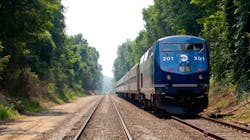MTA Metro-North Railroad celebrates 40th anniversary
On New Years Day, the Metropolitan Transportation Authority (MTA) marked the 40th anniversary of the founding of MTA Metro-North Railroad, which began operation on Jan. 1, 1983. Metro-North has made dramatic advances in service, safety and accessibility, rebuilt the infrastructure it had inherited and made it resilient to climate change, renewed Grand Central Terminal, acquired more than 800 modern new railcars, brought service to seven new stations and implemented the nation’s most-used transit agency app, TrainTime, combining real-time train locations with ticketing and customer service chat. As a result of the investments and improvements, ridership had more than doubled, to 86.6 million trips per year, just prior to the pandemic.
“To see how far Metro-North has come in 40 years gives me, and every Metro-North employee, a deep sense of pride,” said Metro-North President and Long Island Rail Road (LIRR) Interim President Catherine Rinaldi. “A lot has changed since 1983, but the Metro-North core principles remain the same: Providing safe and reliable service and the best customer experience possible. As we look ahead to the next ten years, we hope to celebrate Metro-North's 50th anniversary having fully recovered our pre-pandemic ridership, with a fully rebuilt Park Avenue Viaduct and a new direct service to Penn Station.”
The railroad has activated Positive Train Control, a system that provides an extra layer of safety to train operations while making significant strides in station accessibility for all riders. On-time performance rose from 80.5 percent in 1983 to greater than 97 percent for each of the past three years, even as the number of trains rose from 45 percent from 159,344 in 1985 (the first year for which records are available) to 230,787 annually just before the pandemic. Today, ridership continues its recovery, with Metro-North back to carrying 65 to 70 percent of its pre-pandemic riders.
Metro-North has extended electrification of the Harlem Line 29 miles from North White Plains to southeast. In 2000, Metro-North extended the Harlem Line five miles to two new stations, Tenmile River and Wassaic. A third main track was installed in 2004 between Fleetwood and Crestwood, which provided additional capacity for increased Harlem Line service, new express trains to the Upper Harlem segment, increased service to Bronxville, Tuckahoe and Crestwood and an expanded reverse-peak service, providing access to Westchester employment centers for Manhattan and Bronx residents. In 1999, Metro-North opened a modern, large new station at Cortlandt on the Hudson Line.
In New York City, the railroad restored Grand Central Terminal and the Park Avenue Tunnel that leads to it in the mid-1990s. It completed a new station at Yankees-East 153rd Street in 2009, giving baseball and soccer fans the opportunity to use train service for the first time, and established the Hudson Rail Link connecting shuttle bus service in the Spuyten Duyvil and Riverdale neighborhoods in 1994.
To capture economies of scale, the MTA has unified Metro-North railcar purchasing with the LIRR and has merged policing of the two railroads under the MTA Police Department, created in 1998. More recently, the MTA has brought construction activities at all MTA properties together under MTA Construction and Development to further enhance efficiency by streamlining construction, taking advantage of industry best practices and bundling nearby projects across agency lines.
West of Hudson
Metro-North expanded travel options for West-of-Hudson customers by launching the Haverstraw-Ossining ferry service in 2000 and the Newburgh-Beacon ferry in 2005. The ferries are timed to meet departing and arriving trains on the Hudson Line. In 2007, in partnership with New Jersey Transit, the Pascack Valley Line began weekend service for the first time thanks to the construction of passing sidings at three locations.
In 2011, Metro-North quickly rebuilt the Port Jervis Line with new large culverts and stronger resiliency standards following the severe damage caused by Hurricane Irene.
Connecticut
In partnership with the Connecticut Department of Transportation (CTDOT), the railroad has replaced the century-old catenary wires that power trains on the New Haven Line and brought service to three new stations: Fairfield Metro, New Haven-State Street and West Haven. In partnership with CTDOT, the railroad completed the installation of signals, Positive Train Control and passing sidings on the Waterbury Branch in 2021.
Future
The MTA anticipates continuing to maintain and expand the railroad’s footprint to serve the region in the years ahead. Work has begun on the renewal of the Grand Central Terminal Train Shed, the structure that supports Park Avenue and side streets overhead between 46th and 57th Streets and under which all Grand Central trains pass. Further north, plans are underway to rebuild the Park Avenue Viaduct that carries all trains in and out of Manhattan.
Crews broke ground last year on a second route into Manhattan via the Penn Station Access Project, enabling the railroad to serve four new stations in the East Bronx by 2027 at Hunts Point, Morris Park, Co-op City and Parkchester/Van Nest and to provide direct service to Penn Station for New Haven Line customers. These former transit deserts will now have improved access to employment opportunities in Westchester and Connecticut.
